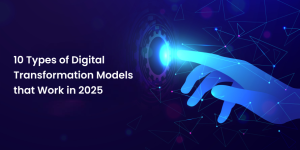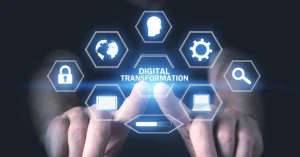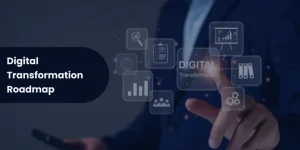Top 15 Digital Transformation Trends to Expect in 2025
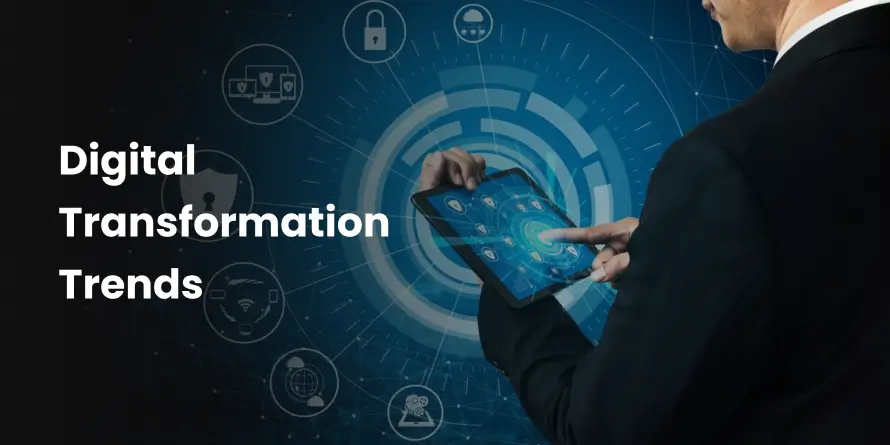
By 2025 digital transformation will not just be a buzzword but the underpinning of businesses wanting to stay ahead. From automating boring tasks such as making your morning coffee for you to controlling your office AC from miles away, technology is changing the way we live and work.
The double-edged sword of accelerated innovation. Companies have harnessed this digital revolution, embracing efficiencies, enhancing customer experiences, and ultimately leveraging innovation to drive growth. With each passing moment, businesses become increasingly aware that digital transformation is no longer just a choice, it is an absolute necessity. A well-structured digital transformation roadmap can help businesses navigate this journey effectively.
According to research, as much as 90% of companies will have experimental or scaled digital transformation strategies by 2025. Those falling behind risk being left behind while forward-thinking business leaders harness contemporary technologies such as AI, ML, IoT, and data analytics to enhance performance and streamline operations.
We would break down digital transformation trends and help our readers understand how automation or solutions driven on AI are together reshaping the architecture of businesses and helping them grow leaps & bounds.
Top Digital Transformation Trends
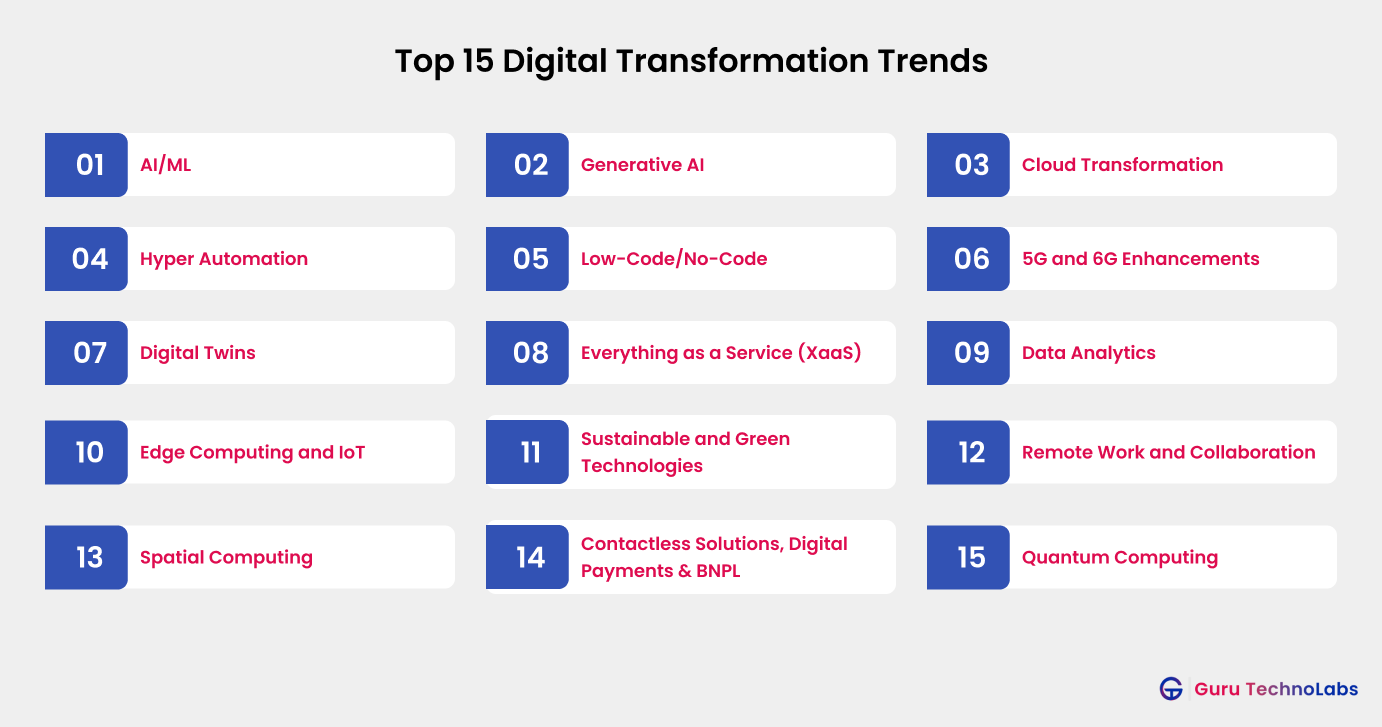
AI/ML
AI and ML are at the core of digital transformation trends, allowing businesses to harness data in powerful ways. Companies like Amazon, Netflix, and Google use AI to offer personalized recommendations, while Google’s machine learning algorithm helps improve search results and customer experiences.
In 2025, AI and ML development will be critical in automating decision-making, improving operational efficiency, and predicting customer behaviour.
Generative AI
Generative AI, which can create content such as images, text or even music, is changing the game for creators and businesses. Platforms like OpenAI’s ChatGPT and DALL-E have brought generative AI into the spotlight, allowing businesses to generate marketing copy, create product designs, or product content at scale.
By 2025, generative AI will become an essential tool for content-heavy industries, from media and entertainment to eCommerce. Companies will leverage this technology to produce high-quality content in less time and at a fraction of the cost, improving customer engagement and brand storytelling.
Learn how digital transformation is revolutionizing eCommerce by enhancing customer experiences with AI-driven solutions.
Cloud Transformation
Cloud transformation is reshaping the way businesses store, manage and access their data. With platforms like Amazon Web Services (AWS), Microsoft Azure, and Google Cloud, organizations can now scale their IT infrastructure faster and more securely, allowing for greater flexibility and cost savings.
In 2025, nearly 94% of businesses will be relying on cloud solutions for critical operations.
Hyper Automation
Hyper Automation is the use of advanced technologies like AI, AI agents, robotic process automation (RPA), and machine learning to automate and end-to-end business processes.
Companies such as UiPath and Automation Anywhere are leading the charge in this space, helping organizations reduce manual tasks, lower operation costs, and increase efficiency.
To better understand how AI agents are being used in real-world scenarios, explore these AI agent examples showcasing their role in hyper automation and beyond.
Whether it’s automating customer service or streamlining supply chain management, hyper automation will play a pivotal role in business transformation.
Low-Code/No-Code
Low-code and No-code platforms are revolutionizing how businesses design applications, enabling non-technical teams to create software solutions.
Companies at the forefront include Salesforce with its Lightning Platform and Microsoft PowerApps, who are empowering organizations to quickly build mobile apps or custom apps without in-depth programming knowledge.
The low-code/no code market will grow by 27% by 2025, enabling companies to respond quickly to shifts in the digital transformation market trends and allowing non-developers (also known as citizen developers) to create the tools that they need.
Take the First Step Towards Digital Transformation with Us
Streamline operations, enhance experiences, and drive growth with our expert guidance.
5G and 6G Enhancements
5G networks are already being rolled out, enabling faster speed and more reliable connections, and in turn, enhancing mobile connectivity. Offering much higher bandwidths with speeds significantly greater than that of their predecessor 5G, 6G will drive low-latency experiences even further into the future.
5G and 6G will be used in important applications, from real-time remote surgery in healthcare to interactive AR or VR shopping experiences in retail.
Other sectors, such as automotive, will also see its advantages, with autonomous vehicles depending on faster networks to process real-time data and for communication.
Digital Twins
Digital twins are virtual replicas of physical objects or systems that allow businesses to simulate, analyze, and optimize their real-world counterparts in real-time.
Companies like Siemens and General Electric are already using digital twins to monitor industrial equipment, predict maintenance needs and improve performance.
For example, in manufacturing, digital twins can simulate an entire production line, allowing businesses to identify inefficiencies and reduce downtime before making changes in the real world.
Everything as a Service (XaaS)
XaaS refers to the growing trend of delivering products and services over the internet on a subscription basis, from software and hardware to entire infrastructure.
Companies like Salesforce, Microsoft and AWS have revolutionized how businesses consume services by offering cloud-based solutions that remove the need for on-premise hardware and software.
By 2025, the XaaS model will continue to disrupt traditional business models, allowing companies to access everything they need from HR management to cybersecurity on-demand, without the upfront costs of purchasing and maintaining physical assets.
Data Analytics
Data analytics is a cornerstone of digital transformation trends, as businesses increasingly rely on data-driven insights to make smarter decisions. Companies like Walmart and Target use data analytics to personalize marketing strategies and optimize supply chains, while financial institutions leverage analytics to detect fraud in real time.
Data will continue to be the key to unlocking growth and gaining a competitive edge.
Edge Computing and IoT
Edge computing and the Internet of Things (IoT) are powering real-time data processing closer to where it is generated, such as in factories, vehicles, or on wearable devices.
Companies like Tesla and Philips are utilizing edge computing to process data from IoT devices on-site, enabling faster response times and reduced bandwidth usage.
Sustainable and Green Technologies
As environmental concerns grow, businesses are adopting sustainable technologies to reduce their carbon footprint. This includes utilizing renewable energy sources, optimizing energy consumption through smart grids, and implementing eco-friendly manufacturing processes.
For instance, Tesla’s development of electric vehicles and solar energy products exemplifies the integration of green technologies in consumer products.
Quantum Computing
Quantum computing is a paradigm shift in processing ability, allowing complex problems to be solved that exceed the capacity of classical computers. Being a novice technology, quantum computing has the potential for progress in logistics, substance research, and elaborate system stimulation.
Many organizations, including IBM and Google, are pouring immense resources into quantum research in the hopes of ushering in new computing potential.
Remote Work and Collaboration
Thanks to the worldwide change in working style brought on by the pandemic, remote employment and collaboration have been the new standard for numerous companies. Companies have swiftly moved to online tools — such as Zoom, Microsoft Teams, and Slack — to help keep teams connected, productive, and engaged, regardless of their location.
For instance, if you can get on most of the meetings and relevant shareable conversations via tools, it would become easier to directly access the tasks irrespective of whether the devices are within the office or home — these tools will emerge better in light of hybrid work models.
Businesses are ready to harness anywhere talent and nurture enhanced work cultures — one that encourages productivity and dignity of work at the same time.
Spatial Computing
Spatial computing is the melding of the digital and physical worlds using technologies such as augmented reality (AR), virtual reality (VR), and mixed reality (MR). It allows individuals to manipulate data in three-dimensional space, fundamentally altering our approach to viewing and processing information.
For instance, Apple’s ARKit and Microsoft’s HoloLens are examples of tools that blend the real and digital worlds, enhancing both user experiences and business processes. By 2025, spatial computing will revolutionize industries such as real estate, education, and retail.
Contactless Solutions, Digital Payments & BNPL (Buy Now, Pay Later)
The demand for contactless solutions, digital payments, and BNPL ( Buy Now, Pay Later) services has surged, especially in the wake of the pandemic. Consumers are increasingly opting for seamless and secure online transactions using digital wallets like Apple Pay, Google Pay or Samsung Pay.
Additionally, BNPL services like Klarna and Afterpay have redefined how consumers shop, offering more manageable payment options. This trend is expected to grow, as millennials and Gen Z prefer the option to pay in installments, making big-ticket purchases more accessible without the immediate financial burden.
Riding the Digital Wave: Join the Transformation Revolution
As the saying goes, “The only constant in life is change.” And in today’s fast-evolving business world, digital transformation is the change you can’t afford to miss. These latest trends in digital transformation such as AI, cloud transformation, remote collaboration, and beyond are not just shaping the future, they’re shaping your future.
Embracing these innovations will give you the tools to stay competitive, improve customer experiences, and drive growth. So, if you want to ride the wave of digital transformation and ensure your business thrives in 2025 and beyond, now is the time to act. Our digital transformation servicescan help you seamlessly integrate advanced technologies and future-proof your business. Let us guide you through this exciting journey, contact us today to begin transforming your business for the digital age!



